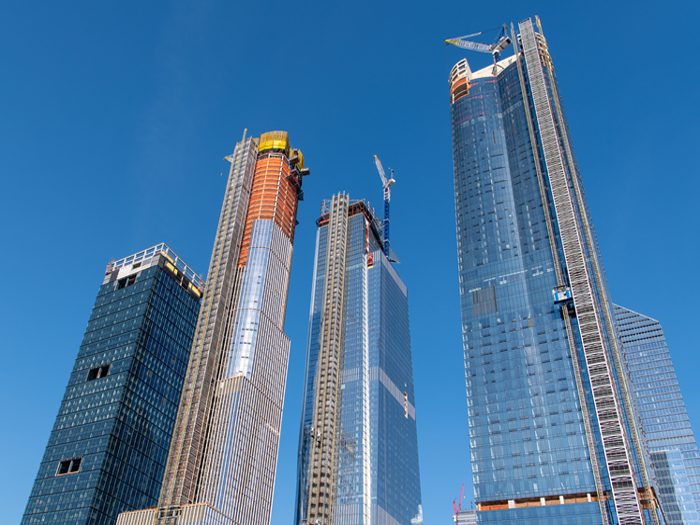6 Ways Hudson Yards Got Resiliency Right … And Why None of It May Matter

You can’t miss Hudson Yards, the massive complex of high rises that has transformed the West side of Manhattan — and at $25 billion, it’s the largest private development project in the United States. Sure, the 18 million-square-feet of commercial and residential space, 100 shops and 4,000 residences are impressive — but the risk management features truly set Hudson Yards apart.
Let’s take a closer look:
1) Storm Proofing
After 2012’s Superstorm Sandy, the Hudson Yards developers knew they needed to plan for the possibility of a similar storm hitting NYC’s shores.
Sandy left 51 square miles, or about 17 percent, of of the city’s total land mass flooded, a report released by the mayor’s office read. 17,000 homes were either severely or moderately damaged, nearly 2 million people were without electricity and 43 people died. The estimated cost of damage after the storm was $19 billion, with $50 billion in property damage.
To combat this, a massive set of “submarine doors” seals off and waterproofs all critical infrastructure in Hudson Yards, like fuel pump rooms and elevator pits. Many mechanical elements are also raised significantly in its storm proofing efforts.
2) Security for Terror Attacks or Violence
Dealing with concerns about terrorism is nothing new for New York developers. The Hudson Yards team consulted with various security agencies, including former New York City Police Commissioner Raymond Kelly, according to the Wall Street Journal, in order to create a safe environment for residents.
Although exact security details are limited to the public, there appear to be plans in place for truck bombs, active shooters or chemical attacks.
3) Power that Never Goes Out
Hudson Yards is also poised to be one of New York’s most energy-efficient Class A office towers and will feature 1.2 MW of gas-fired micro turbines that generate power, hot water and chilled water. They are promised to have twice the efficiency of standard systems — even in the event of a loss of power to the New York City electrical grid.
The developers noted that this onsite power-generation capacity will also keep basic building services, residences and restaurant refrigerators running whatever the disturbance — brown out, superstorm, etc.
4) Rainwater Harvesting
Hudson Yards is set up to harness nearly 10 million gallons of storm water per year from building roofs and public plazas. The facility is equipped to collect rainwater from the roof and uses it to replenish cooling towers and irrigate its 28,000 plants and 200 trees.
That takes a serious burden off the New York City sewer system.
5) Garbage Processing Plant
The Department of Sanitation in NYC handles 12,000 tons of garbage per day; currently, the city carts that trash from these waste transfer stations to landfills as far 650 miles away. One report found that recyclable materials — such as textiles, plastic bags and electronics — make up 9 percent of that waste, which means only an estimated 23 percent of the city’s waste is actual trash that should go to a landfill.
In Hudson Yards, that’s about to change.
Hudson Yards will make organic waste collection convenient by having three waste chutes in each residential building for trash, recyclables and organic waste, utilizing grinders and dehydrators in commercial kitchens to reduce the volume of food-service waste. Additionally, the development is equipped with choppers and grinders.
With all these efforts in place, the complex hopes to reduce food waste by 20 percent.
6) High Exposure, Seemingly Palatable Risks
Hudson Yards has plenty of risks that will make insurers take notice: a high profile; exposure to storms and serious weather; 125,000 people passing through each day.
There’s no doubt that it could be a target for terrorism or mass shooting events or fall victim to a major storm. But its cutting-edge risk management and security protocols should make the risk much more palatable to the market. Hudson Yards is more than just a collection of luxury skyscrapers, noted Business Insider: “It’s also a fortress that’s built to survive off-grid in the event of hurricanes, floods, or terrorist attacks.”
Yet Glaring Safety Risk Remains
No matter how safe you make a complex, it’s still dependent on the city infrastructure around it, said Billy Grayson, the executive director of the Urban Land Institute’s Center for Sustainability and Economic Performance, who spoke to Business Insider. “No building is off-grid because every building needs roads to bring people to it.
“If the city is not making the right investments in resilient infrastructure, even if the buildings can run perfectly, it’s still not going to save them from those extreme weather events.”
He also cautioned against thinking the complex is totally safe in the event of a disaster: “Even if I have a beautiful condo. I don’t want to be stuck in it for a month while they’re trying to dig out the subway or rebuild the roads that connected me to the rest of Manhattan.”
Despite seemingly having everything, Hudson Yards doesn’t have a local fire station, something that prompted a letter from the Uniformed Firefighters Association to Mayor Bill de Blasio expressing safety concerns.
“In his letter, Gerard Fitzgerald said his department was already ‘stretched thin’ trying to serve the community near the Eastern and Western Rail Yards, which includes neighborhoods like Chelsea and Hell’s Kitchen,” Business Insider reported. “Without a new fire station in the area, hundreds of thousands of lives could be put at risk.”










